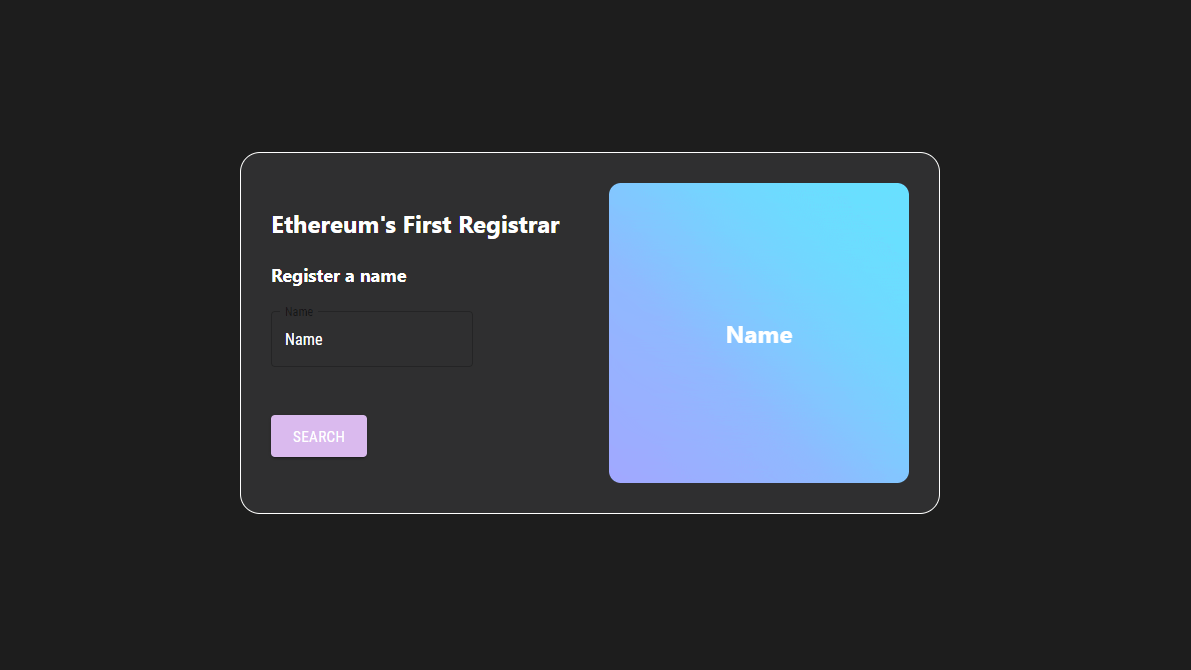When it comes to historic NFT projects, the general rule is: older means better. Although legacy collections like CryptoPunks, CryptoKitties, and Curio Cards have gained newfound popularity in the last few years, the fact that we can trace their provenance back through the annals of the blockchain contributes a wealth of historical and cultural value to these projects.
Yet, while many collectors pride themselves on obtaining relic tokens of old, it seems a single, classic NFT collection has eluded even those who purport to be NFT historians. With the resurgence of Linagee Name Registrar, the collective NFT community has found itself in awe of the utility-based project, which is almost as old as the Ethereum blockchain itself.
Linagee Name Registrar
Linagee Name Registrar is a simple domain name registrar created for the Ethereum blockchain. Those who have familiarized themselves with Ethereum Name Service (ENS) are sure to understand the power and significance of creating and owning a shorthand name linking directly to their Ethereum wallet.
The name registry service was, as the name suggests, created by an anonymous Ethereum developer named Linagee — who also holds the accolade of deploying the very first ever smart contract on Ethereum. Shortly after deploying the Name Registrar, Linagee took to Reddit to announce the project.
Deployed on August 8, 2015, Linagee Name Registrar is only a single week older than the Ethereum blockchain, which was launched on July 30, 2015. NFT archeologist Mason Keresty rediscovered the project while he was decompiling every contract within the first 300,000 blocks of the Ethereum blockchain. It seems the project had mostly been forgotten and was essentially inaccessible to general NFT enthusiasts.
Since only 60 domain names were initially minted on the contract back in 2015, in an effort to integrate the project back into the NFT ecosystem, Keresty created a new minting app linking to the original smart contract. Shortly after, the new app was shared throughout the NFT community, resulting in the newly founded Linagee OpenSea collection that grew exponentially as enthusiasts raced to register their names.
How does the Name Registrar work?
The Linagee Name Registrar works very similarly to ENS in the way that users can purchase and manage domain names for their wallets. There are a few differences, though, with two of the most prominent being that a) Linagee currently only seems to function as a domain for Ethereum wallets (as opposed to ENS being usable for naming websites, wallets, NFTs, and other digital assets, and b) with Linagee, users can reserve their names indefinitely, while ENS makes users select and pay for a specific period.
Linagee registrar allows users to claim names by using the “reserve” function. Through reserving users can set a domain name for their wallet using the “setAddress” function. Keep in mind that a name can only be reserved once. If someone already purchased your specific name, it will show up as unavailable, and will probably only be obtainable via OpenSea.
The new Linagee site also allows for the wrapping and transferring of domain names, further expanding the operability of the Registrar system. You can learn more about this and its other functionalities here.
4/ The contract was found by @m_keresty who is also the one who created the minting app. Here is a quick rundown that he gave of the functions on the contract: pic.twitter.com/bnAUzAioeo
— Leonidas.og (@LeonidasNFT) September 30, 2022
Considering the Linagee Registrar dates back to before the majority of NFT collectors had even been exposed to the weird wide world of crypto, the significance of the project cannot be overstated. Yet, significance aside, time will tell if the project can maintain its usability and desirability as a part of today’s more mature NFT market.
Read More: nftnow.com










 Bitcoin
Bitcoin  Ethereum
Ethereum  XRP
XRP  Tether
Tether  Solana
Solana  USDC
USDC  Cardano
Cardano  Dogecoin
Dogecoin  TRON
TRON  Lido Staked Ether
Lido Staked Ether  Wrapped Bitcoin
Wrapped Bitcoin  Chainlink
Chainlink  Toncoin
Toncoin  LEO Token
LEO Token  Stellar
Stellar  Wrapped stETH
Wrapped stETH  USDS
USDS  Hedera
Hedera  Pi Network
Pi Network  Avalanche
Avalanche  Sui
Sui  Shiba Inu
Shiba Inu  Litecoin
Litecoin  Polkadot
Polkadot  Bitcoin Cash
Bitcoin Cash  MANTRA
MANTRA  WETH
WETH  Bitget Token
Bitget Token  Ethena USDe
Ethena USDe  Binance Bridged USDT (BNB Smart Chain)
Binance Bridged USDT (BNB Smart Chain)  Hyperliquid
Hyperliquid  Wrapped eETH
Wrapped eETH  Uniswap
Uniswap  WhiteBIT Coin
WhiteBIT Coin  Monero
Monero  sUSDS
sUSDS  Aptos
Aptos  NEAR Protocol
NEAR Protocol  Dai
Dai  OKB
OKB  Pepe
Pepe  Internet Computer
Internet Computer  Gate
Gate  Ethereum Classic
Ethereum Classic  Ondo
Ondo  Tokenize Xchange
Tokenize Xchange  Mantle
Mantle  Aave
Aave  Coinbase Wrapped BTC
Coinbase Wrapped BTC